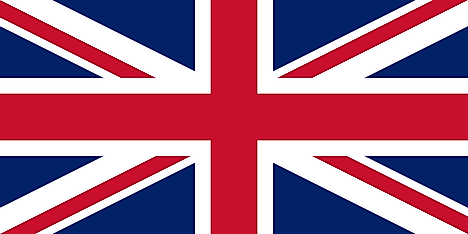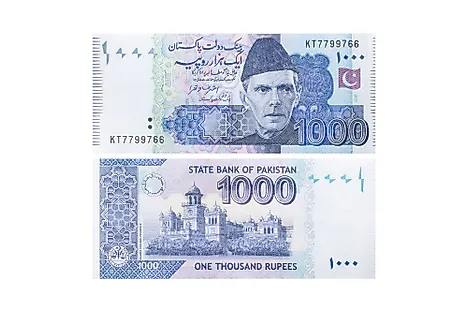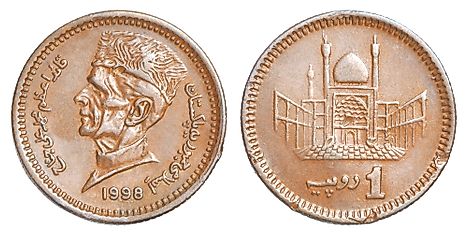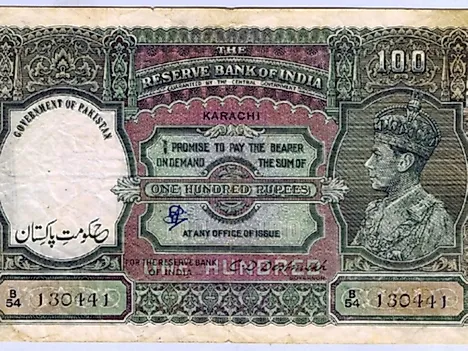Flags, Symbols & Currency of Pakistan
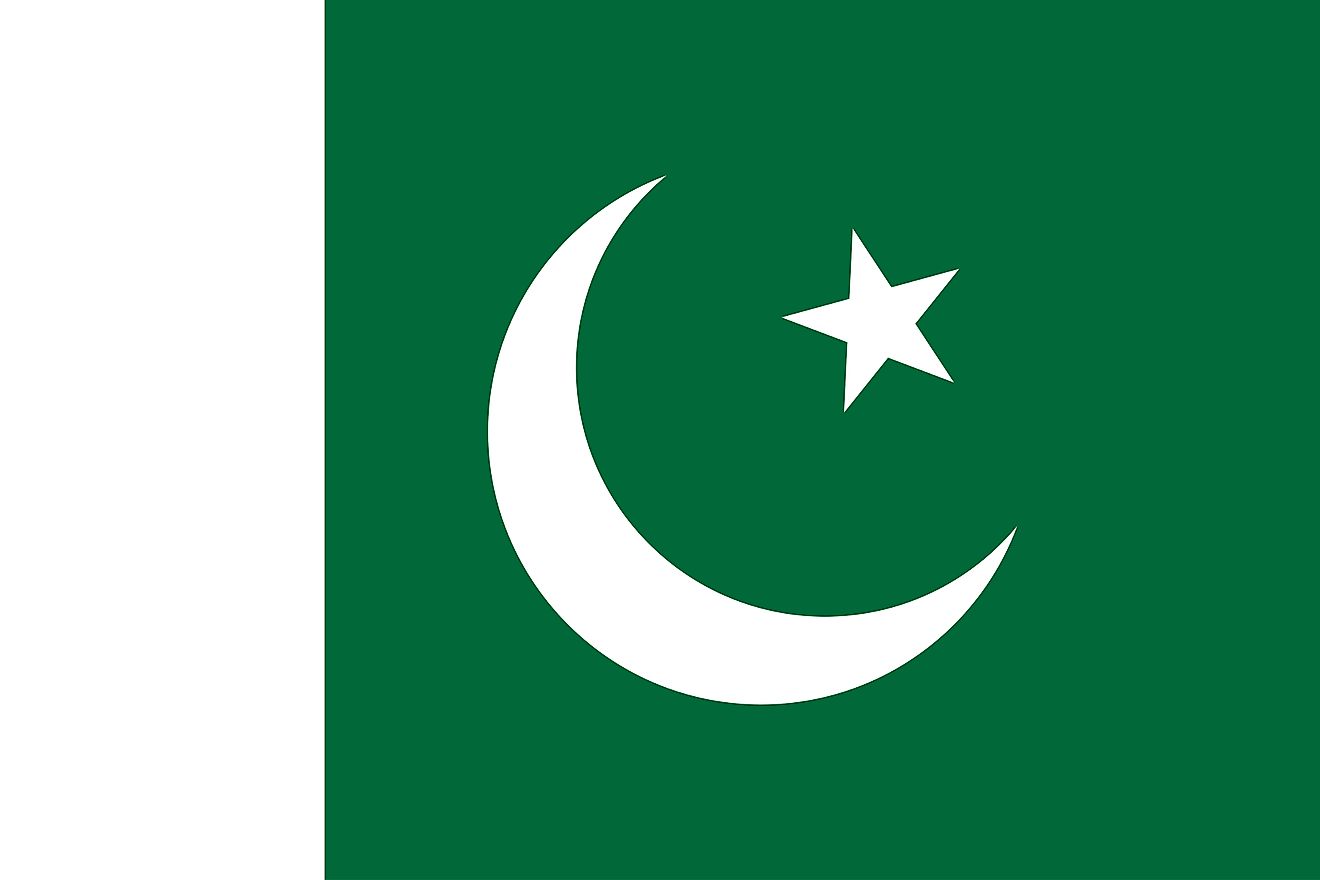
The National Flag of Pakistan was officially adopted on August 11, 1947. The flag has been designed by Syed Amir-Uddin Kidwai.
The National Flag of Pakistan features a green field with a vertical white stripe on the hoist side of the flag. A large white crescent and a five-rayed star are centered in the green field. The green color represents Islam (the dominant religion followed by a vast majority of the country). The white stripe stands for all the colors of the spectrum and hence represents the minority religions and their followers in Pakistan. The combination of green and white colors represent peace and economic success. The white crescent is a symbol of future progress and the star symbolizes light and knowledge. Both the crescent and the star are traditional symbols of Islam. The flag as a whole is said to represent the country’s commitment to Islam while protecting the rights of the religious minorities residing in the country. The flag has a width-to-length ratio of 2:3.
History of the Flag of Pakistan
The design of the national flag of Pakistan is based on the flag of the All-India Muslim League, a body that fought for the creation of an Islamic state. The flag of this body was, in turn, designed based on the flags of the Sultanate of Delhi, the Mughal Empire, and the Ottoman Empire. The Muslim League flag featured a green background with a white star and crescent – all of which are symbols of Islam. The Muslim League flag differed from the modern-day flag, where a vertical stripe is placed at the hoist-side of the flag. The modern-day flag was officially adopted as the national flag of Pakistan by the Constituent Assembly on August 11, 1947.
Symbols of Pakistan
The National Coat of Arms of Pakistan

The current official National Coat of Arms of Pakistan was adopted in 1954. It features the green color of the flag and the star and crescent symbols of Islam. A shield is depicted in the center of the emblem featuring the four major crops of Pakistan: cotton, jute, tea, and wheat. Surrounding the shield is a floral wreath of Poet's Jasmine representing the Mughal heritage, as well as the national flower of Pakistan (Jasminum officinale). Below the wreath is a scroll reading, "Iman, Ittihad, Nazm" ("Faith, Unity, Discipline").
National Motto
"Iman, Ittihad, Nazm" ("Faith, Unity, Discipline").
National Anthem
- Anthem Title: Qaumī Tarānah
- Music Composer: Ahmed Ghulamali Chagla
- Lyricist: Hafeez Jullandhuri
- Date of Adoption: August 13, 1954
Qaumī Tarānah is the national anthem of Pakistan. The music of the anthem have been composed by Ahmed Ghulamali Chagla. The lyrics have been authored by Hafeez Jullandhuri. The anthem was officially adopted on August 13, 1954.
قومی ترانہ (Urdu (Nastaʿlīq script))
پاک سرزمین شاد باد
كشورِ حسين شاد باد
تُو نشانِ عزمِ عالی شان
ارضِ پاکستان!
مرکزِ یقین شاد باد
پاک سرزمین کا نظام
قوّتِ اُخوّتِ عوام
قوم، ملک، سلطنت
پائنده تابنده باد!
شاد باد منزلِ مراد
پرچمِ ستاره و ہلال
رہبرِ ترقّی و کمال
ترجمانِ ماضی، شانِ حال
جانِ استقبال!
سایۂ خدائے ذوالجلال
Blessed be the sacred land,
Happy be the bounteous realm.
Thou symbol of high resolve,
O Land of Pakistan!
Blessed be the citadel of faith.
The order of this sacred land,
The might of the brotherhood of the people,
May the nation, the country, and the state,
Shine in glory everlasting!
Blessed be the goal of our ambition.
The flag of the crescent and star,
Leads the way to progress and perfection,
Interpreter of our past, glory of our present,
inspiration for our future!
Shade of God, the Glorious and Mighty.
The Currency of Pakistan is the Pakistani rupee
The current official currency of Pakistan is the Pakistani rupee (Rs). It is commonly pronounced as “rupaya,” “rupaye” or “rupees” in Pakistan. The State Bank of Pakistan, which is the country's central bank, issues the currency.
Coins
The denominations of 1 pice, ½, 1, and two annas, ¼, ½, and 1 rupee entered the market in 1948. An addition of 1 pie coins occurred in 1951. The issuance of the 1, 5, and ten pice and one paisa, 5, and ten paise coins took place in the year 1963, although 1, 5, and ten pices came first. The 1-rupee coins re-entered the market in 1979 while 2 rupees and 5 rupees joined in 1998 and 2002 respectively. The production of the 5, 10, 25, and 50 paise stopped in 1996. Most of the rupees between the present two types have clouds on top of Badshahi Masjid. There were changes of 1 and two rupees to aluminum in the year 2007. Since 2003, the 1 rupee has remained the only minimum legally accepted coin for tendering after the legal use of the paisa designated coins stopped. On October 15, 2015, the government of Pakistan issued a reviewed 5-rupee coin with a lesser weight and smaller size which is made of copper-nickel-zinc composition. 50 rupees coins were introduced in 2019, to mark the 550th birth anniversary of Sri Guru Nanak Dev Ji and to commemorate the opening of the new Kartarpur Gurdwara in Pakistan.
Banknotes
On April 1, 1948, India’s government and the Reserve Bank of India produced and circulated probationary notes on behalf of the Pakistani government. These notes were used only in Pakistan with no buybacks in India. The government issuance started in 1948 and they were issued in 1, 5, 10, and 100 rupees until the 1980s when production of 1 rupee notes ceased while the State Bank of Pakistan assumed the responsibility of producing other notes. The 2, 5, 10, and 100 rupees banknotes were circulated in 1953. An addition of 50 rupees in 1957 was followed by reintroduction of 2 and 500 rupees in 1986 and 1987 respectively. Additional notes of 20 and 5,000 rupees occurred in 2005 and 2006 respectively. The banknotes featured Bengali, the state language in Bangladesh (former East Pakistan) until the year 1971. The image of Muhammad Ali Jinnah appeared on all notes apart from the 1 and 2 rupees on the faces while the backs have different features with text written in English. Also, all banknotes have a watermark to improve security issues with various sets of other security threads featuring on every note.
Historical currencies of Pakistan
Rūpiya is a word borrowed from the Sanskrit word rūpya which stands for “a coin of silver, wrought silver,” a descriptive word that means shapely. The rūpaya used to refer to the coin that Sher Shah Suri started issuing during his regime from 1540 to 1545 CE. In 1947, the dissolving of the British Raj led to the introduction of the Pakistani rupee. Before then, Pakistan used British Indian notes and coins with “Pakistan” over-stamped on them. In 1948, an introduction of new banknotes and coins took place, subdivided into 16 annas. However, the currency was converted into decimals on January 1, 1961. The rupee was divided into 100 pice (paise) later the year. No coins designated in paise have ever been produced since 1994.
